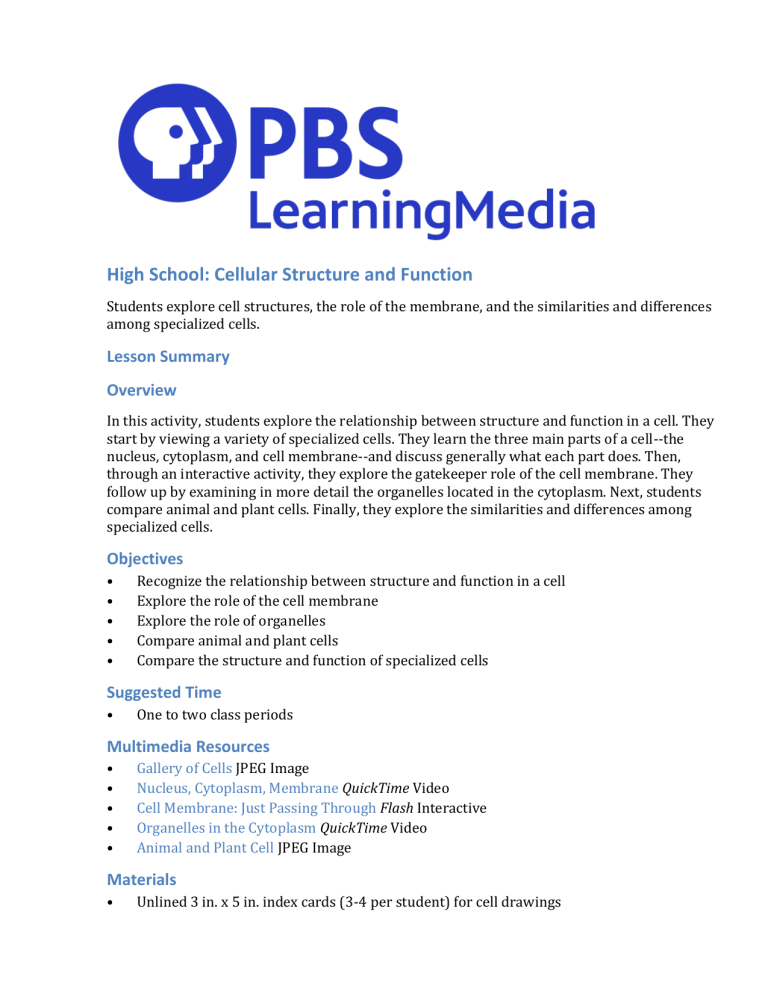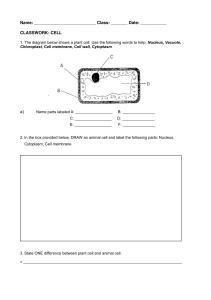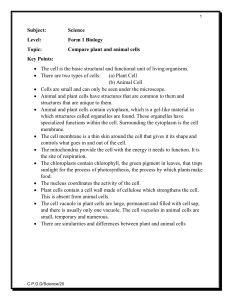
High School: Cellular Structure and Function Students explore cell structures, the role of the membrane, and the similarities and differences among specialized cells. Lesson Summary Overview In this activity, students explore the relationship between structure and function in a cell. They start by viewing a variety of specialized cells. They learn the three main parts of a cell--the nucleus, cytoplasm, and cell membrane--and discuss generally what each part does. Then, through an interactive activity, they explore the gatekeeper role of the cell membrane. They follow up by examining in more detail the organelles located in the cytoplasm. Next, students compare animal and plant cells. Finally, they explore the similarities and differences among specialized cells. Objectives • • • • • Recognize the relationship between structure and function in a cell Explore the role of the cell membrane Explore the role of organelles Compare animal and plant cells Compare the structure and function of specialized cells Suggested Time • One to two class periods Multimedia Resources • • • • • Gallery of Cells JPEG Image Nucleus, Cytoplasm, Membrane QuickTime Video Cell Membrane: Just Passing Through Flash Interactive Organelles in the Cytoplasm QuickTime Video Animal and Plant Cell JPEG Image Materials • Unlined 3 in. x 5 in. index cards (3-4 per student) for cell drawings After the Lesson • Have students explore a variety of plant and animal cells under a microscope and identify the cell structures described in this lesson. Have students measure cells to compare sizes. The Lesson Part I 1. Have students explore the Gallery of Cells stills to see the variety of specialized cells that exist in organisms. Then show the Nucleus, Cytoplasm, Membrane video and discuss the following: • • • How does the structure of a cell suggest its function? In what way does the nucleus dictate the structure and function of the cell? How does the cell membrane act as the "gatekeeper" for the cell? 2. Have students explore the Cell Membrane: Just Passing Through interactive activity. Discuss the following: • • How does the composition of the cell membrane help regulate the movement of substances into and out of the cell? Describe the different processes involved in the movement of these substances into and out of the cell: oxygen, carbon dioxide, glucose, potassium, sodium, water, and enzymes. 3. Show the Organelles in the Cytoplasm video. Ask: • • • • What is meant by the phrase "the cell is the functional unit of life"? How are the organelles in a cell like the organs in a human body? Why do you think cells that produce large numbers of proteins have more rough endoplasmic reticulum (ER) than cells that produce fewer proteins? In which kinds of human cells would you expect to find the most mitochondria? The most lysosomes? The most ribosomes? Explain your answers. 4. Have students examine the Animal and Plant Cell stills and identify the similarities and differences between the two types of cells. Ask: • What is the most significant difference between animal and plant cells? Why do you think that? 5. Have students explore the Gallery of Cells stills again, this time looking for similarities and differences in the cells. Ask them to draw at least three different types of specialized cells on separate index cards and to label the cell type (animal or plant) and any recognizable cell structures. Then have students compare the different cells and describe how their structures are related to their functions. Reprinted from PBS LearningMedia: High School: Cellular Structure and Function https://www.pbslearningmedia.org/resource/tdc02.sci.life.cell.lp_strufx/cellular-structureand-function/ © 2013-02-27 19:00:00 GBH. All Rights Reserved. For personal or classroom use only. Not for redistribution.






